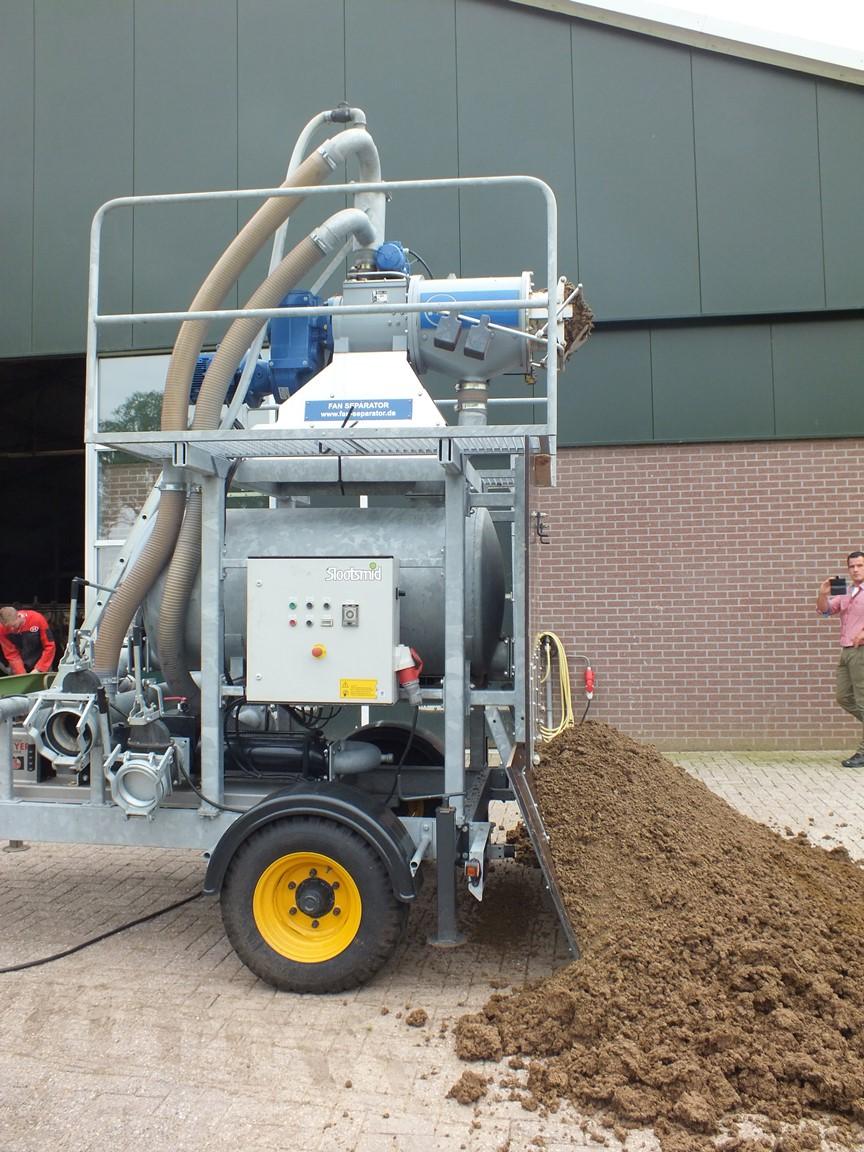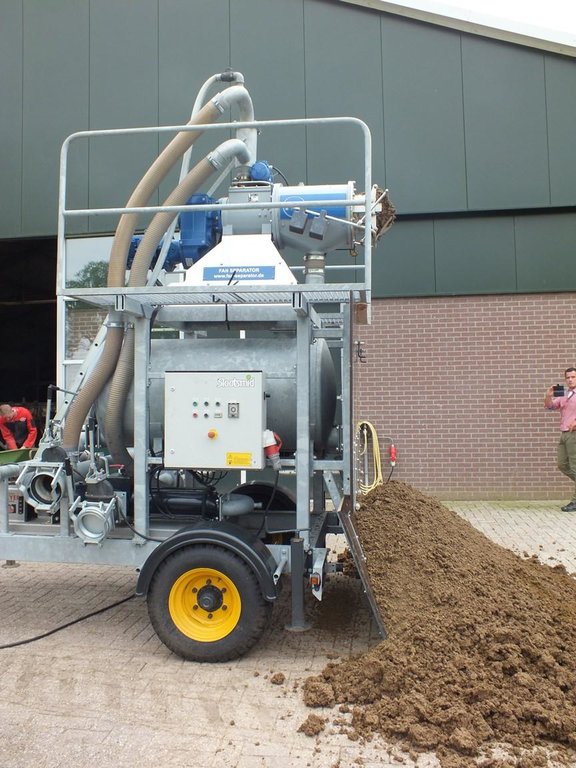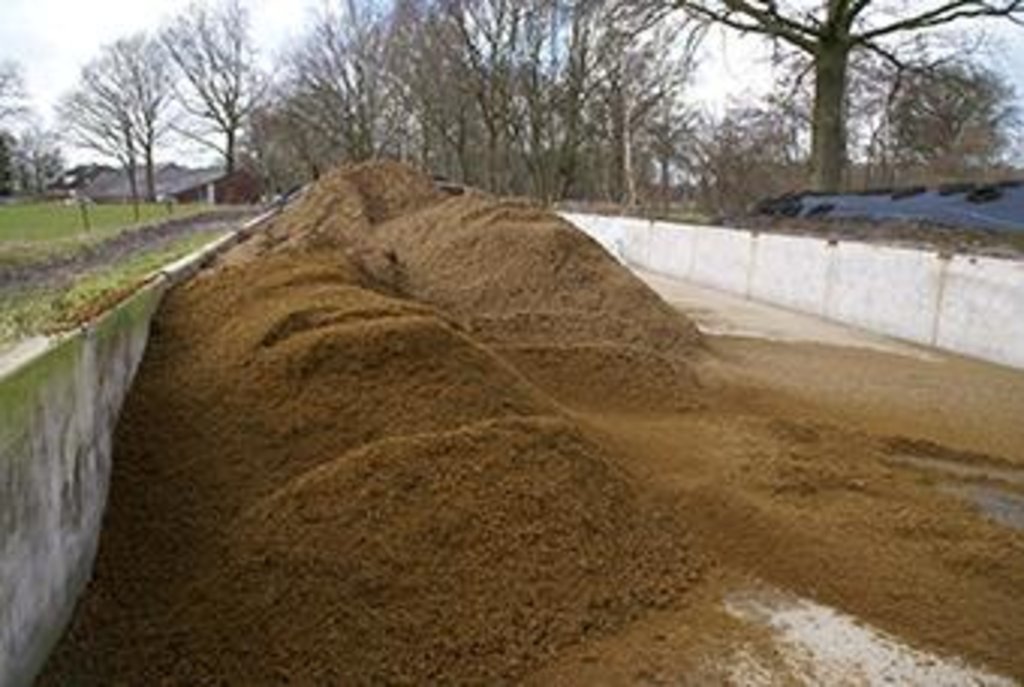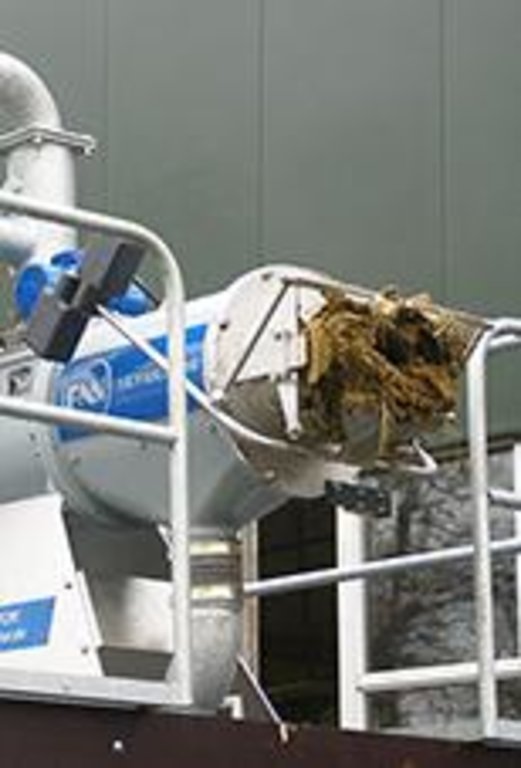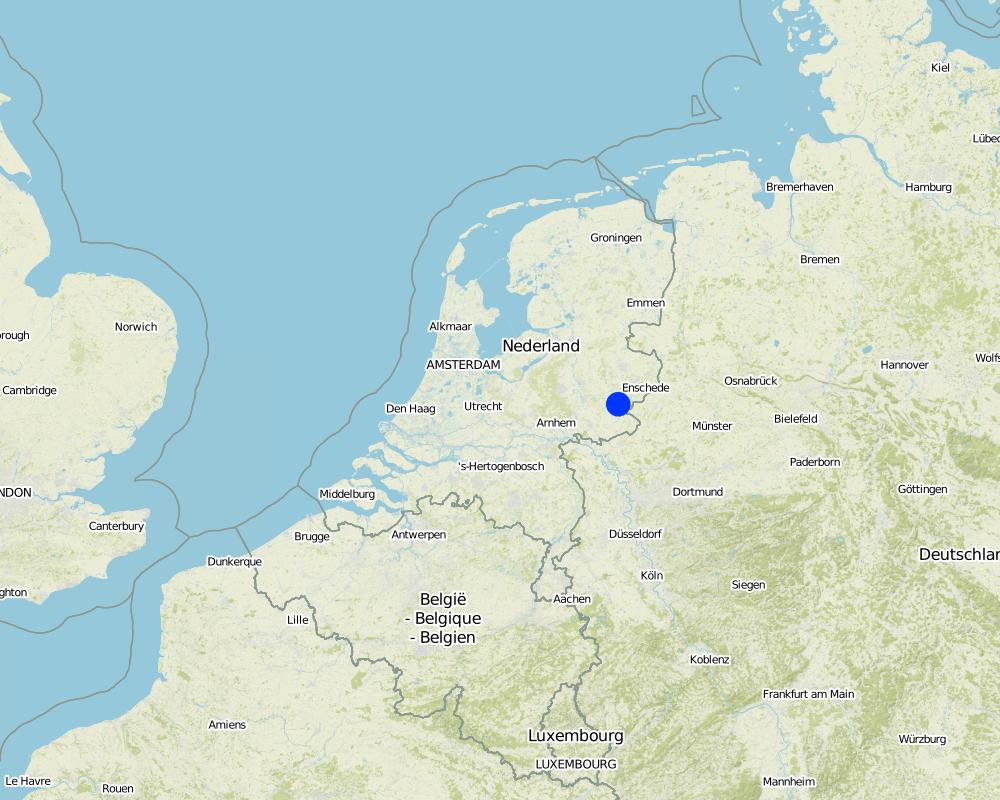Manure separation to better distribute organic matter at farm level [Netherlands]
- Creation:
- Update:
- Compiler: Simone Verzandvoort
- Editor: –
- Reviewers: Fabian Ottiger, Alexandra Gavilano
Mestscheiding om organische stof op bedrijfsniveau beter te verdelen (NL)
technologies_1256 - Netherlands
View sections
Expand all Collapse all1. General information
1.2 Contact details of resource persons and institutions involved in the assessment and documentation of the Technology
SLM specialist:
Smit Annemieke
Wageningen Environmental Research (Alterra)
Netherlands
SLM specialist:
Leever Henk
HOEDuurzaam
Netherlands
SLM specialist:
Rienks Willem
Rom3D
Netherlands
Name of project which facilitated the documentation/ evaluation of the Technology (if relevant)
Preventing and Remediating degradation of soils in Europe through Land Care (EU-RECARE )Name of the institution(s) which facilitated the documentation/ evaluation of the Technology (if relevant)
Hoe Duurzaam - NetherlandsName of the institution(s) which facilitated the documentation/ evaluation of the Technology (if relevant)
ROM3D - NetherlandsName of the institution(s) which facilitated the documentation/ evaluation of the Technology (if relevant)
Wageningen Environmental Research (Alterra) - NetherlandsName of the institution(s) which facilitated the documentation/ evaluation of the Technology (if relevant)
Provincie Gelderland - NetherlandsName of the institution(s) which facilitated the documentation/ evaluation of the Technology (if relevant)
Vitens - Laat Water Voor Je Werken - Netherlands1.3 Conditions regarding the use of data documented through WOCAT
The compiler and key resource person(s) accept the conditions regarding the use of data documented through WOCAT:
Yes
2. Description of the SLM Technology
2.1 Short description of the Technology
Definition of the Technology:
Separation of cow manure is a common practice on dairy farms in The Netherlands to improve the nutrient use efficiency.
2.2 Detailed description of the Technology
Description:
Het primaire doel van mestscheiding is de productie van een dikke
fractie met hoge gehalten aan organische stof en mineralen en een laag vochtgehalte. Een dergelijke geconcentreerde
fosfaatrijke fractie is een waardevolle organische meststof en kan over grote afstand vervoerd worden. De
dunne waterige fractie, met daarin het grootste deel van de stikstof, kan op eigen grond of in de nabije omgeving als
meststof worden aangewend of verder worden gezuiverd tot loosbaar water.
Slurry manure is fed through a manure separator that separates much of the thick material from the liquid portion. These fractions differ in the proportion between P and N; the thick fraction contains relatively more P than the thin fraction.
The thick fraction is used on maize fields or as substrate in cow stables; the thin fraction, with the larger part of the nitrogen, can be used on other parts of the farm or is exported from the farm to be treated for discharge in the environment. Due to stricter regulations for the application of N and P to crop land and grassland, less manure may be applied to the land. If manure must be exported because the threshold for P is reached, this implies that also N is exported from the farm.
Purpose of the Technology: Slurry from livestock consists of more than 90% of water. The primary purpose of manure separation is to produce a thick fraction with high contents of organic matter and nutrients and a low moisture content. The thick fraction is a valuable fertiliser and can be transported over large distances. The thin fraction, with the larger part of the nitrogen, can be applied as fertiliser on the farm, on farmland in the proximity, or can be treated into a quality suitable for discharge in the environment or water drainage system.
Manure separation allows farmers to use organic matter from manure more efficiently at the farm level. Manure separation increases the efficiency of processing and using manure in 5 ways:
1. By concentrating phosphorus in the thick fraction the volume of manure to be exported can be decreased, and also the export of nitrogen from the farm.
2. Manure separation creates three types of manure (thick, thin and mixed), which allows for differentiated application to different fields and crops, and reductions on requirements for artificial fertiliser.
3. Manure separation decreases the volume of manure to be exported from farms, and therefore saves energy and transport costs.
4. The thick fraction can be stored in stacks, taking up less space.
5. The thick fraction can be used as substrate in stables, replacing costly sawdust.
Establishment / maintenance activities and inputs: Purchase a manure separator. Periodically feed your collected slurry manure through the separator and then apply the thick portion to your fields. Discard the liquid portion.
Natural / human environment: Dairy farming on sandy soils in the eastern part of The Netherlands. Stricter manure regulation originting from the Nitrates Directive sets a limit on the amounts of animal manure for farms on sandy and loess soils in the eastern and southern part of The Netherlands.
2.3 Photos of the Technology
2.5 Country/ region/ locations where the Technology has been applied and which are covered by this assessment
Country:
Netherlands
Region/ State/ Province:
Gelderland
Further specification of location:
Haarlo - Oude Eibergen
Specify the spread of the Technology:
- evenly spread over an area
If precise area is not known, indicate approximate area covered:
- < 0.1 km2 (10 ha)
Comments:
The thick manure fraction is applied to corn fields. There is 240 ha of corn in the area amongst 44 farmers. Only 2 farmers are applying this technology.
Map
×2.6 Date of implementation
If precise year is not known, indicate approximate date:
- less than 10 years ago (recently)
2.7 Introduction of the Technology
Specify how the Technology was introduced:
- through projects/ external interventions
Comments (type of project, etc.):
The land users's initiative was through the application for the project Healthy Sand by a group of farmers. During the Gezond Zand Project the group organised themselves in the Foundation HOEDuurzaam. The project ran from 2012-2014 and is followed by the new project BodemRijk.
The external initiative was from the drinking water company Vitens and the Province of Gelderland in the same period.
3. Classification of the SLM Technology
3.2 Current land use type(s) where the Technology is applied

Cropland
- Annual cropping
Annual cropping - Specify crops:
- cereals - maize
- cereals - other
- fodder crops - grasses
- root/tuber crops - potatoes
Number of growing seasons per year:
- 1
Specify:
Longest growing period in days: 250Longest growing period from month to month: March-November

Grazing land
Intensive grazing/ fodder production:
- Cut-and-carry/ zero grazing
- Improved pastures
Comments:
Major cash crop annual cropping: Potatoes
Major food crop annual cropping: Maize, cereals
Major food crop perennial (non-woody) cropping: Grass
Major land use problems (compiler’s opinion): Decrease of soil organic matter content.
Major land use problems (land users’ perception): The group of farmers in the area expeience decreasing organic matter content in soil.
Cut-and-carry/ zero grazing: feeding in stables
Improved pasture: feeding in field
Livestock density: > 100 LU /km2
3.4 Water supply
Comments:
Water supply: rainfed, mixed rainfed - irrigated, rainfed, mixed rainfed - irrigated
3.5 SLM group to which the Technology belongs
- integrated soil fertility management
3.6 SLM measures comprising the Technology

agronomic measures
- A2: Organic matter/ soil fertility
Comments:
Main measures: agronomic measures
Type of agronomic measures: manure / compost / residues
3.7 Main types of land degradation addressed by the Technology

chemical soil deterioration
- Cn: fertility decline and reduced organic matter content (not caused by erosion)
Comments:
Main type of degradation addressed: Cn: fertility decline and reduced organic matter content
Main causes of degradation: soil management (Intensive ploughing)
Secondary causes of degradation: crop management (annual, perennial, tree/shrub) (Intensive crop management)
3.8 Prevention, reduction, or restoration of land degradation
Specify the goal of the Technology with regard to land degradation:
- restore/ rehabilitate severely degraded land
Comments:
Main goals: rehabilitation / reclamation of denuded land
4. Technical specifications, implementation activities, inputs, and costs
4.1 Technical drawing of the Technology
Technical specifications (related to technical drawing):
Slurry manure is the influent placed into the separator. A drill-press pushes the slurry and pressure squeezes out the liquid portion (Liqour). The thick manure (cake) is pressed out the end. The screen holds the solid material in the drill press.
Location: not applicable. not applicable
Date: 13-01-2008
Technical knowledge required for field staff / advisors: moderate (The agricultural advisor should advise on options for application of the thick fraction of manure based on composition.)
Technical knowledge required for land users: moderate (Farmer has to calculate and strategize distribution of thick manure fractions and RDM(slurry) to reach balanced application rates and consider impact between fields.)
Technical knowledge required for technical advisor from machine company: moderate (Technical advisor should advise on type of manure separator (screw or roller) depending on the intended use of the thick and thin fractions.)
Main technical functions: increase in organic matter
Secondary technical functions: increase in nutrient availability (supply, recycling,…)
Manure / compost / residues
Material/ species: Thick fraction obtained by separation of manure from dairy cows.
Quantity/ density: 10 t/ha
Remarks: The thick fraction is applied separately from the slurry.
Author:
Extension, http://www.extension.org/pages/27470/solids-separation-in-swine-manure-handling-systems#.VU9uDk0cRoI
4.2 General information regarding the calculation of inputs and costs
other/ national currency (specify):
Euro
If relevant, indicate exchange rate from USD to local currency (e.g. 1 USD = 79.9 Brazilian Real): 1 USD =:
0.94
Indicate average wage cost of hired labour per day:
255.70
4.3 Establishment activities
| Activity | Timing (season) | |
|---|---|---|
| 1. | Buy a seperator |
4.4 Costs and inputs needed for establishment
| Specify input | Unit | Quantity | Costs per Unit | Total costs per input | % of costs borne by land users | |
|---|---|---|---|---|---|---|
| Equipment | Seperator | Machine | 1.0 | 5320.0 | 5320.0 | |
| Total costs for establishment of the Technology | 5320.0 | |||||
| Total costs for establishment of the Technology in USD | 5659.57 | |||||
Comments:
Life span of the seperator: 6 years
Number of parties sharing: 44
4.5 Maintenance/ recurrent activities
| Activity | Timing/ frequency | |
|---|---|---|
| 1. | Operating separator | once per year |
| 2. | Applying both thick fraction manure and RDM manure | once per year |
4.6 Costs and inputs needed for maintenance/ recurrent activities (per year)
| Specify input | Unit | Quantity | Costs per Unit | Total costs per input | % of costs borne by land users | |
|---|---|---|---|---|---|---|
| Labour | Labour | ha | 1.0 | 127.68 | 127.68 | 100.0 |
| Labour | Sampling manure | ha | 1.0 | 21.28 | 21.28 | 100.0 |
| Equipment | Machine use | ha | 1.0 | 308.56 | 308.56 | 100.0 |
| Equipment | rent of manure separator | h | 1.0 | 16.5 | 16.5 | 100.0 |
| Equipment | depreciation costs | m3 | 1.0 | 0.65 | 0.65 | |
| Equipment | maintenance | machine | 1.0 | 0.3 | 0.3 | |
| Equipment | Electricity | ha | 1.0 | 3.72 | 3.72 | 100.0 |
| Fertilizers and biocides | Extra Potassium | ha | 1.0 | 10.64 | 10.64 | 100.0 |
| Total costs for maintenance of the Technology | 489.33 | |||||
| Total costs for maintenance of the Technology in USD | 520.56 | |||||
Comments:
Machinery/ tools: Separator, truck, loader, tractor
Cost of everything per hour was multiplied by totals and divided by hectares applied so costs per hectare are given. The establishment cost of the separator is the total unit. It was purchased by the farmer's foundation. It can not be given in a cost per hectare.
4.7 Most important factors affecting the costs
Describe the most determinate factors affecting the costs:
Labour. Equipment.
5. Natural and human environment
5.1 Climate
Annual rainfall
- < 250 mm
- 251-500 mm
- 501-750 mm
- 751-1,000 mm
- 1,001-1,500 mm
- 1,501-2,000 mm
- 2,001-3,000 mm
- 3,001-4,000 mm
- > 4,000 mm
Specifications/ comments on rainfall:
182 days of precipitation annually
Agro-climatic zone
- sub-humid
Thermal climate class: temperate. Mean monthly temperature varies between 2-17 °C ( LGP 240-269 days, mean monthly temperature varies between 2-17 °C)
5.2 Topography
Slopes on average:
- flat (0-2%)
- gentle (3-5%)
- moderate (6-10%)
- rolling (11-15%)
- hilly (16-30%)
- steep (31-60%)
- very steep (>60%)
Landforms:
- plateau/plains
- ridges
- mountain slopes
- hill slopes
- footslopes
- valley floors
Altitudinal zone:
- 0-100 m a.s.l.
- 101-500 m a.s.l.
- 501-1,000 m a.s.l.
- 1,001-1,500 m a.s.l.
- 1,501-2,000 m a.s.l.
- 2,001-2,500 m a.s.l.
- 2,501-3,000 m a.s.l.
- 3,001-4,000 m a.s.l.
- > 4,000 m a.s.l.
Comments and further specifications on topography:
Altitudinal zone: 0-100 m a.s.l. (up to 45 metres a.s.l.)
Slopes on average: Flat and gentle (only incidentally.)
5.3 Soils
Soil depth on average:
- very shallow (0-20 cm)
- shallow (21-50 cm)
- moderately deep (51-80 cm)
- deep (81-120 cm)
- very deep (> 120 cm)
Soil texture (topsoil):
- coarse/ light (sandy)
- medium (loamy, silty)
Topsoil organic matter:
- high (>3%)
- medium (1-3%)
If available, attach full soil description or specify the available information, e.g. soil type, soil PH/ acidity, Cation Exchange Capacity, nitrogen, salinity etc.
Soil depth on average: Deep (A and B horizons up till 40 cm in Gleyic Podzols and Umbric Gleysols (ca 75% of the area). Hardly any soil organic matter below 15 cm. Rooting depth is up to 80 cm.) and very deep (deep topsoils rich in organic matter in the Fimic Anthrosols (12% of the area).)
Soil texture is coarse/light (most soils have a sandy texture due to the substrate consisting of cover sands) and medium (Soils in former creek valleys contain loam (Umbric Gleysols))
Soil fertility is low (Most soils have a low fertility due to the sandy substrate (specifically the Gleyic Podzols, ca 40% of the area)) and very high (in Fimic Anthrosols originated due to application of farmyard manure since medieval times (12% of the area))
Topsoil organic matter is medium (the purpose of the technology is to increase soil organic matter at farm level)
Soil drainage/infiltration is good (deep groundwater table (H>40-80 cm; L>120 cm) in the sandy soils on thick substrate of cover sands (in 65% of the area)) and medium (shallow groundwater tables in the Umbric Gleysols (35% of the area).
Soil water storage capacity is medium (in the other soils, varying with the soil organic matter content) and very high (in the Fimic Anthrosols with high SOM in the topsoil.)
5.4 Water availability and quality
Ground water table:
< 5 m
Availability of surface water:
medium
Water quality (untreated):
poor drinking water (treatment required)
Comments and further specifications on water quality and quantity:
Ground water table: <5m (in all soil types the highest level of the groundwater table during the year is <140 cm below the soil surface. The lowest level can be lower than 120 cm)
Availability of surface water is medium (From small rivers (De Berkel) and creeks)
Water quality (untreated) is poor drinking water (levels of the pesticides Bentazon and MCPP in the groundwater have incidentally exceeded the norms for drinking water production between 1985 and 2009)
5.5 Biodiversity
Species diversity:
- medium
Comments and further specifications on biodiversity:
Soil biodiversity is high in the Fimic Anthrolsols.
5.6 Characteristics of land users applying the Technology
Market orientation of production system:
- mixed (subsistence/ commercial)
- commercial/ market
Off-farm income:
- less than 10% of all income
Relative level of wealth:
- average
Individuals or groups:
- individual/ household
Level of mechanization:
- mechanized/ motorized
Gender:
- men
Indicate other relevant characteristics of the land users:
Land users applying the Technology are mainly common / average land users
Difference in the involvement of women and men: Most outdoor farm operations are completed by men. Women often have jobs outside the farm.
Population density: 10-50 persons/km2
Annual population growth: < 0.5%
100% of the land users are average wealthy and own 100% of the land.
Off-farm income specification: Some farmers are contractual workers. Wives of farmers often have a job, e.g. at the municipality or craft work. Farms do not provide B&B or educational services.
Market orientation of cropland production system is mixed ( Maize is completely used to feed cows (max 20% of the area is allowd under maize); other arable crops are sold to the market. Dairy production is commercial. )
Market orientation of grazing land production system is commercial/market (dairy farmers grow feed crops for their livestock)
5.7 Average area of land used by land users applying the Technology
- < 0.5 ha
- 0.5-1 ha
- 1-2 ha
- 2-5 ha
- 5-15 ha
- 15-50 ha
- 50-100 ha
- 100-500 ha
- 500-1,000 ha
- 1,000-10,000 ha
- > 10,000 ha
Is this considered small-, medium- or large-scale (referring to local context)?
- medium-scale
Comments:
Average area of land owned or leased by land users applying the Technology: 5-15 ha, 15-50 ha, 50-100 ha
Cropland per household: 15-50 ha (6 land owners (situation in 2014)) and 50-100 ha (15 land owners, situation in 2014)
Grazing land per household: 5-15 ha (average grassland is 7.8 ha per household)
5.8 Land ownership, land use rights, and water use rights
Land ownership:
- individual, titled
- Other forms of exploitation
Land use rights:
- leased
- individual
Comments:
Many fields have other forms of exploitation than individual ownership or lease.
5.9 Access to services and infrastructure
health:
- poor
- moderate
- good
education:
- poor
- moderate
- good
technical assistance:
- poor
- moderate
- good
employment (e.g. off-farm):
- poor
- moderate
- good
markets:
- poor
- moderate
- good
energy:
- poor
- moderate
- good
roads and transport:
- poor
- moderate
- good
drinking water and sanitation:
- poor
- moderate
- good
financial services:
- poor
- moderate
- good
6. Impacts and concluding statements
6.1 On-site impacts the Technology has shown
Socio-economic impacts
Production
crop production
Comments/ specify:
expected, based on better targeted fertiliser application
Water availability and quality
demand for irrigation water
Comments/ specify:
expected due to increase of SOM
Income and costs
expenses on agricultural inputs
Comments/ specify:
On artificial fertiliser (30-80% reduction on N fertiliser) and substrate for cow stables. But since the thick fraction contains less N per kg of P2O5 than the original mix, farners applying the thick fraction (for maize as described in this QT) may need to apply more articial N-fertilizer
farm income
Comments/ specify:
Decreased costs for manure export from the farm: A smaller part of the total manure mix needs to be exported (ca 35% less N-export than without manure separation; 10-30% less net energy use)
Other socio-economic impacts
Ease of manure storage
Comments/ specify:
Thick fraction is less voluminous and can be stacked
Manure processing
Comments/ specify:
Thick fraction can be more easily stored and transported; thin fraction takes up less volume and does not need to be transported.
Energy use
Quantity before SLM:
4-7 GJ/ha
Quantity after SLM:
3-5 GJ/ha
Comments/ specify:
Energy use for manure transport, processing, digestion and fertiliser use
Expenses on machinery
Comments/ specify:
For farms with less than 1000-2000 tons of manure to be separated expenses on manure separation become larger than benefits. Such farms could better hire a mobile separator, as in the descirption of this SLM technology.
Socio-cultural impacts
Improved livelihoods and human well-being
Comments/ specify:
Dairy farmers have learned more about the importance of soil organic matter for their production systems, and about the consequences of soil and manure management on soil organic matter and other aspects of soil health. This learning was brought by the exchange of knowledge between farmers and experts, and between farmers themselves. Farmers also profited from services provided to them by the farmers' foundations: shared investments (e.g. in the manure separator) and support in the application for subsidies to finance the SLM measure.
Ecological impacts
Water cycle/ runoff
water quality
Comments/ specify:
expected: reduction in leaching of nitrate and phosphorus due to better targeted manuring to plant needs
Soil
soil moisture
Comments/ specify:
due to increased SOM
soil organic matter/ below ground C
Comments/ specify:
due to improved manure composition for crop growth and build-up of SOM
Climate and disaster risk reduction
emission of carbon and greenhouse gases
Comments/ specify:
due to better targeted fertiliser use to needs of crops and reduced use of artificial fertiliser (30-80% less supply of N-fertiliser required)
Other ecological impacts
Emission of NH3
Quantity before SLM:
18
Quantity after SLM:
20
Comments/ specify:
NH3 loss in kg/ha, for dairy farms with 1.75 cows/ha, manure prod of 255 kg N/haand other assumptions; model estimate
P2O5 surplus
Quantity before SLM:
1
Quantity after SLM:
4
Comments/ specify:
P2O5 surplus in kg/ha, same conditions
6.2 Off-site impacts the Technology has shown
groundwater/ river pollution
Quantity before SLM:
12.5
Quantity after SLM:
10.4
Comments/ specify:
Reduced leaching of nitrate from fields where manure is applied due to less surplus of N in thin fraction(NO3-N in groundwater in mg/lfor farm with 1.75 dairy cows/ha)
Energy use
Quantity before SLM:
4-7 GJ/ha
Quantity after SLM:
3-5 GJ/ha
Comments/ specify:
Energy use for transport of manure from farms, processing, digestion, fertiliser use
6.3 Exposure and sensitivity of the Technology to gradual climate change and climate-related extremes/ disasters (as perceived by land users)
Gradual climate change
Gradual climate change
| Season | increase or decrease | How does the Technology cope with it? | |
|---|---|---|---|
| annual temperature | increase | well |
Climate-related extremes (disasters)
Meteorological disasters
| How does the Technology cope with it? | |
|---|---|
| local rainstorm | well |
| local windstorm | well |
Climatological disasters
| How does the Technology cope with it? | |
|---|---|
| drought | well |
Hydrological disasters
| How does the Technology cope with it? | |
|---|---|
| general (river) flood | well |
Other climate-related consequences
Other climate-related consequences
| How does the Technology cope with it? | |
|---|---|
| reduced growing period | well |
Comments:
The technology is almost independent on environmental change, since it depends on the availability of manure. It is strongly dependent on the farming system (supply of manure and possibility to apply the separated fractions on farm).
6.4 Cost-benefit analysis
Comments:
There is no evidence yet on economic and agronomic effects of using the manure separator in the area, so the land user's perspective cannot be given. Assessments of costs, effects and energy use based on modelling are available in the literature for dairy and arable farming in the NL in Schroder et al. (2009). These reveal that for farms with 1.75 to 2.18 dairy cows/ha and under conditions of manure production and application and manure regulations for this part of The Netherlands, the required export of N-manure could decrease by 35%, required N-fertiliser by 30-80%, and net energy use by 10-30%.
6.5 Adoption of the Technology
If available, quantify (no. of households and/ or area covered):
2
Comments:
100% of land user families have adopted the Technology with external material support
2 land user families have adopted the Technology with external material support
Comments on acceptance with external material support: The Foundation HOEDuurzaam purchased the manure separator. Farmers can use the machine for 15 euros/hour, and can apply for a subsidy from the Province when applying the technology. Two farmers were actively using the machine in 2014.
Comments on adoption trend: We do not have information on how many farmers were using the manure separator in 2015. This information will become available in 2016.
6.7 Strengths/ advantages/ opportunities of the Technology
| Strengths/ advantages/ opportunities in the land user’s view |
|---|
|
increases soil organic matter How can they be sustained / enhanced? continued application of the measure and subsidy for maintenance of the manure separator by the Foundation; support to farmers in calculating parameters for manure separation specific for their farm (type of manure, concentrations, fields to apply to, livestock intensity) |
| energy saving and reduced loss of N while maintaining equal levels of crop production |
| Strengths/ advantages/ opportunities in the compiler’s or other key resource person’s view |
|---|
|
increases soil organic matter How can they be sustained / enhanced? continued application of the measure and subsidy for maintenance of the manure separator by the Foundation; support to farmers in calculating parameters for manure separation specific for their farm (type of manure, concentrations, fields to apply to, livestock intensity) |
| increases available soil moisture |
| reduces leaching of nitrate to the groundwater |
| reduces energy use for manure handling and transport |
6.8 Weaknesses/ disadvantages/ risks of the Technology and ways of overcoming them
| Weaknesses/ disadvantages/ risks in the compiler’s or other key resource person’s view | How can they be overcome? |
|---|---|
| there is still little experience with manure separation and there are many uncertainties relating to separation efficiency and financial aspects |
7. References and links
7.1 Methods/ sources of information
7.3 Links to relevant online information
Title/ description:
Mestscheiding: relaties tussen techniek, kosten, milieu en landbouwkundige waarde - Jaap Schröder, Fridtjof de Buisonjé, Gerrit Kasper, Nico Verdoes & Koos Verloop, Plant and Animal Sciences Groups Wageningen UR, 2009.
URL:
http://edepot.wur.nl/50884
Links and modules
Expand all Collapse allLinks
No links
Modules
No modules


